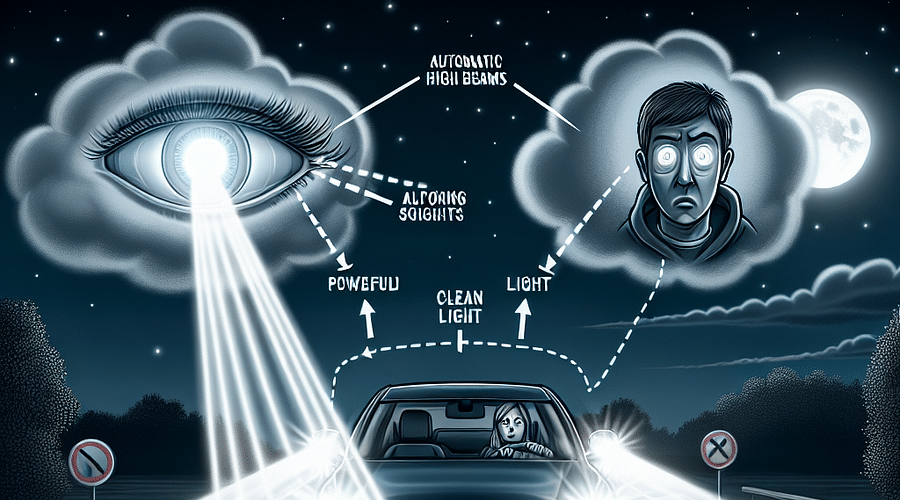The Impact of Automatic High Beams on Night Driving: Balancing Convenience and Courtesy

As night falls and visibility diminishes, high beams become an essential tool for safe driving. But with the advent of automatic high beam systems, drivers are faced with a choice: trust the technology or take manual control. This quiz will test your understanding of when to use high beams manually and when to rely on the automated system, ensuring you balance convenience with courtesy on the road.
Moreover, not all automatic high beam systems are created equal. The sensitivity and responsiveness can vary between manufacturers and models, which means that some systems might be more courteous than others. It's important for drivers to understand how their vehicle's system works—not only for their own convenience but also out of respect for other road users.
In addition to understanding your own vehicle’s system, it’s equally critical to be aware of how other vehicles’ lights affect you as a driver. For instance, dealing with bright headlights from trailing cars can be just as disruptive as facing an oncoming vehicle with full beams glaring.
On one hand, we have those who champion these automated systems as guardians in the night—understanding their function reveals a design aimed at reducing nighttime accidents significantly. On the other hand, skeptics worry about potential lapses in these systems' decision-making abilities.
To address such concerns, it’s essential for drivers to remain engaged with their surroundings despite technological aids—a concept reinforced by studies suggesting that reliance on features like blind spot monitors may lead some drivers to become less attentive. The key is finding harmony between leveraging technology for safety while maintaining active driving participation.
[community_poll: What's your take on automatic high beam usage? Are they more helpful or disruptive?] In conclusion—well, let’s not get ahead of ourselves just yet! We're only halfway through our nocturnal journey into automatic high beam territory. Stay tuned as we continue exploring this topic further in our next segment where we'll look at real-world scenarios where automatic high beams shine (pun intended) or fall short in practice.Automatic high beams are not just about flipping a switch and forgetting about it. There's a delicate balance between their convenience and the courtesy we owe to other drivers on the road. It's essential to understand when these systems can be more of a hindrance than a help. For instance, the sensitivity of some automatic high beam systems may not always correctly determine when to dim the lights, which can lead to dazzling other drivers. To prevent such scenarios, familiarize yourself with your vehicle's settings and adjust them if necessary for optimal performance.
While automatic high beams significantly improve visibility during nighttime driving, they are part of a broader ecosystem of driver-assist technologies. For example, night vision driving assistance uses infrared cameras to detect pedestrians or animals beyond the reach of your headlights. Pairing such systems with automatic high beams ensures that you have a comprehensive safety net when driving after dark.








In addition, understanding how these technologies interact is crucial. For instance, knowing whether your rear cross-traffic alert system remains active while using high beams can be vital information in certain driving conditions. Dive deeper into this topic by exploring the legal requirements for having blind spot monitors and rear cross traffic alerts in a car.
Maintaining road etiquette with automatic high beams goes beyond just letting technology take the wheel. It's about being proactive in ensuring your driving aids do not impede others' safety. Always be ready to manually override your automatic high beams if you notice oncoming traffic or when approaching vehicles from behind – this is where being attentive pays off significantly.
Automatic high beams are a convenient feature for night driving, but there are times when manual override is necessary to ensure safety and courtesy. Test your knowledge on when to take control of your high beams!
Sometimes, other drivers may not extend the same courtesy with their headlights, leaving you squinting through the glare. When faced with this situation, there are strategies you can employ to mitigate the discomfort and maintain focus on the road; learn more by reading about how to deal with bright headlights from cars behind you.
Fostering an environment where all drivers understand and utilize their vehicle's features responsibly is key to safer roads. Participate in our community by taking our quiz on automatic high beam usage and benefits, or share your experiences and tips on our forum.
Automatic high beams can be a boon for night-time driving, but they can also be a source of frustration for other drivers. What's your take on the etiquette of using automatic high beams?
In summary, while automatic high beams offer undeniable advantages for nighttime driving, they require drivers to remain engaged and considerate. By combining these innovative features with good old-fashioned driving etiquette and leveraging complementary technologies, we can all contribute to making night drives safer for everyone.
To further hone your knowledge on this subject and ensure you're using your vehicle's capabilities to their fullest—and most courteous—extent, explore our comprehensive guides on proper usage and benefits of automatic high beams or troubleshoot any issues with our step-by-step guide at troubleshooting your automatic high beams.
Remember that safe driving is a continuous learning process; stay informed, stay courteous, and drive safely.
Post a comment